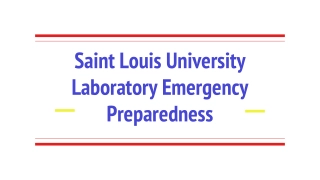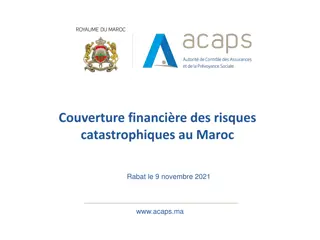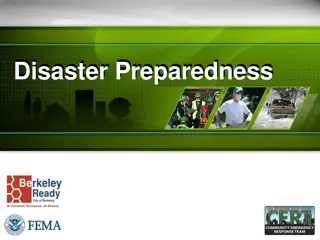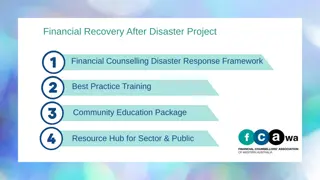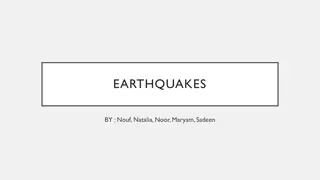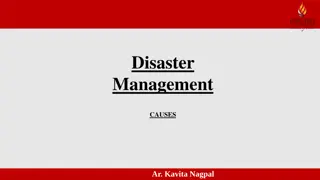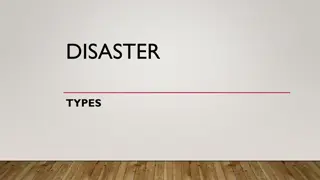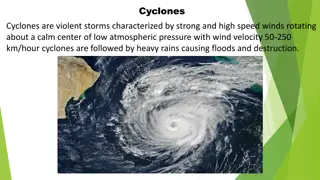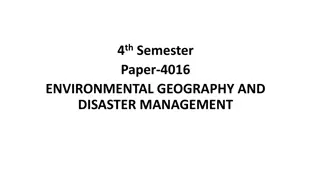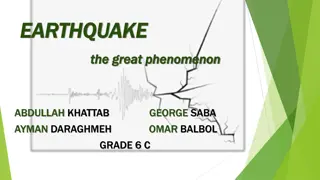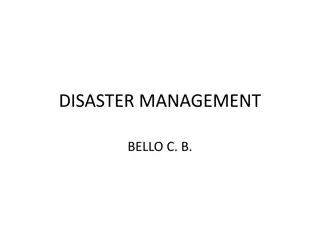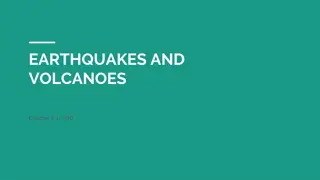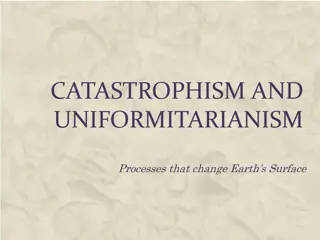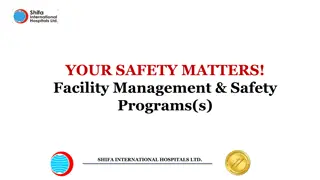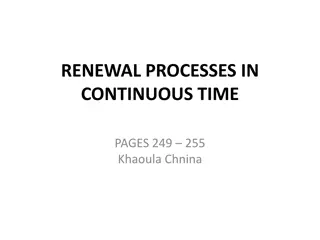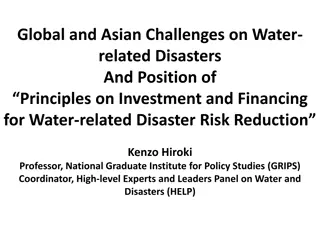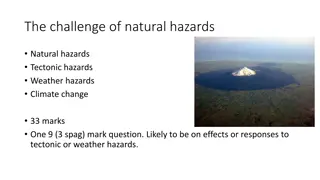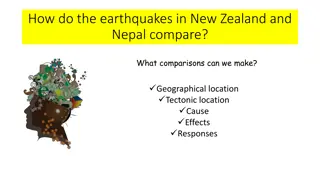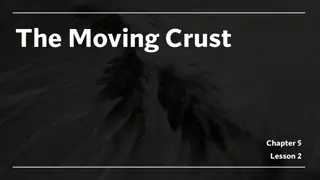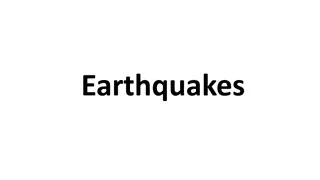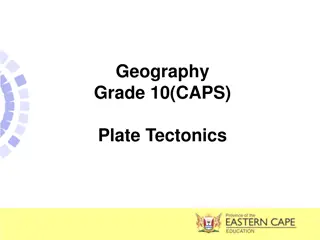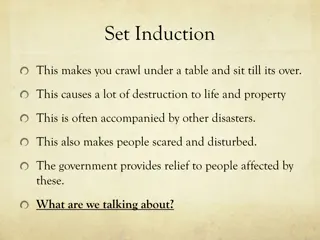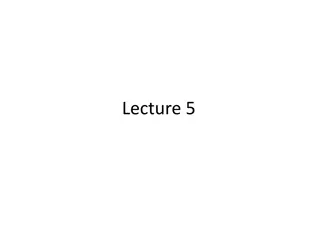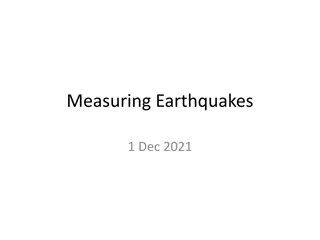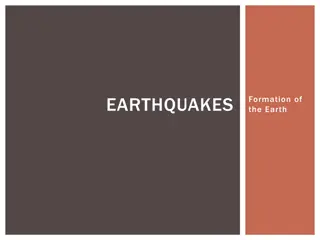Laboratory Emergency Preparedness and Safety Measures
Understanding the importance of laboratory emergency preparedness to ensure safety in various scenarios like severe weather, floods, winter weather, earthquakes, and fires. Proper procedures and individual responsibility play a crucial role in minimizing risks and enhancing recovery in emergencies.
0 views • 19 slides
Risk Management and Catastrophic Events in Morocco
The article discusses the financial coverage of catastrophic risks in Morocco, including historical catastrophic events such as earthquakes, floods, and challenges in implementing a coverage regime. It highlights the architecture of the coverage regime, objectives, challenges, and solutions faced in
0 views • 14 slides
Unraveling the Complexity of Physical Geography for Easier Learning
Explore the accessibility of physical geography in comparison to other geographical aspects, debunk myths surrounding its difficulty, identify challenging topics like geological timescale and earthquakes, and discover strategies to make physical geography inclusive and engaging for students and educ
3 views • 12 slides
Internal Disaster Preparedness in Berkeley: Basic Guidelines
Explore the basics of disaster preparedness in Berkeley, covering topics such as different types of disasters, key elements to consider, common hazards in the area, and ways to mitigate risks. Discover the importance of community preparedness and the local hazard mitigation plan for Berkeley. Be inf
5 views • 48 slides
Financial Recovery After Disaster Project: Comprehensive Framework for Community Resilience
This project focuses on financial recovery after disasters through financial counseling, disaster response frameworks, best practice training, and community education resources. It emphasizes understanding disaster risk governance, fostering individual responsibility, and identifying community champ
6 views • 5 slides
Understanding Earthquakes: Causes, Impacts, and Solutions
Delve into the world of earthquakes with a comprehensive guide covering what they are, their causes, factors affecting intensity, detection methods, impacts on the environment, and possible solutions. Explore resources for further knowledge on seismic activities.
5 views • 9 slides
Understanding Earth's Interior through Seismic Waves: Part 1
Seismic waves provide crucial evidence about Earth's composition and structure. By analyzing the behavior of primary, secondary, and surface waves, scientists can determine the different layers and materials within the Earth. Primary waves travel through both solid and liquid parts, while secondary
10 views • 10 slides
Understanding Plate Tectonics: Meaning, Concepts, and Plate Margins
Plate tectonics is a scientific theory explaining the movement of Earth's lithospheric plates. Developed by various scientists, it involves the drifting of plates over the Earth's surface, leading to phenomena like earthquakes and mountain formation. The theory is based on continental drift and sea-
5 views • 7 slides
Reading and Listening: How People Help Others - Lesson 5 English Family and Friends Grade 6 Unit 7
In this lesson, students learn about helping others through reading and listening activities. They discover new words related to charity and disasters like famine and earthquakes. The lesson includes identifying meanings of words, matching them, and completing sentences to reinforce comprehension. I
5 views • 11 slides
Understanding Natural Disasters and Their Causes
Explore the various types of natural disasters such as meteorological, geophysical, hydrological, climatological, and biological events, each with unique causes like storms, earthquakes, floods, droughts, wildfires, and more. Learn how these disasters impact the environment and living organisms.
9 views • 16 slides
Exploring Types of Waves and Energy Transport
Discover the various types of waves such as transverse, longitudinal, surface, and electromagnetic waves, along with their characteristics and applications in energy transportation. Learn about the differences between mechanical and electromagnetic waves, how waves transmit energy, and their signifi
3 views • 10 slides
Understanding Tides and Earthquake Triggers
Spring tides occur when the moon is new or full, resulting in higher high tides and lower low tides. Neap tides follow, with moderate tides. Tides can trigger earthquakes due to stress and tidal components like normal and shear stresses. Statistical tests analyze the tidal phase angles at the time o
0 views • 25 slides
How To Anchor Furniture To A Wall: A Comprehensive Guide
If you have any children or pets or you live in a place where earthquakes are common, you need to know how to attach furniture to walls. Anchoring furniture can reduce the risk of tip-over and help prevent serious injury and damage. It is a relatively simple and quick process. We'll show you how to
1 views • 4 slides
Understanding Different Types of Disasters and Their Impact
Disasters, whether natural or man-made, can cause massive disruptions leading to human suffering, economic loss, and environmental damage. Natural disasters like earthquakes and cyclones, geological disasters such as volcanic eruptions, hydrological disasters like tsunamis, and climatological disast
0 views • 11 slides
Understanding Cyclones and Tsunamis: Causes, Effects, and Management
Cyclones and tsunamis are natural disasters that can have devastating effects such as strong winds, heavy rains, floods, and destruction. Cyclones are violent storms with high-speed winds rotating around a calm center of low pressure, while tsunamis are seismic sea waves caused by earthquakes or und
0 views • 9 slides
Understanding Earthquakes: Causes and Impacts Explained
Earthquakes are natural events caused by the release of energy along faults in Earth's crust. Tectonic earthquakes, the most common type, occur due to movements of tectonic plates. Volcanic earthquakes and human-induced earthquakes also exist, each with specific triggers. Earthquakes are highly dest
0 views • 12 slides
Understanding Earthquakes: Causes, Effects, and Intensity Factors
Earthquakes are sudden shaking movements of the Earth's surface caused by various factors like tectonic plate movements, volcanic eruptions, mining, and construction. They result in ground shaking, rupture, tsunamis, and landslides, with intensity influenced by factors such as distance from the epic
0 views • 10 slides
Understanding Disaster Management: Definition, Impact, and Examples
A disaster is any occurrence causing damage, ecological disruption, or loss of life on a scale requiring an extraordinary response. This article explores the definition of disasters, their impact on communities and infrastructure, the importance of emergency response, types of hazards, vulnerability
1 views • 51 slides
Contrasting Reactions to Flavors and Traumatic Events
Children and adults demonstrate varying responses to flavors influenced by the number of taste buds in their mouth, while individuals affected by traumatic events like earthquakes can experience lasting changes in their sense of security, as seen through different behaviors and reactions over time.
0 views • 17 slides
Understanding Earthquakes and Volcanoes: a Comprehensive Overview
Earthquakes are vibrations in the ground caused by movement along faults in the Earth's lithosphere. They occur mostly near plate boundaries and are difficult to predict. Different types of faults and seismic waves play a crucial role in understanding these natural phenomena. Seismologists study ear
0 views • 19 slides
Plate Boundaries and Geological Events in California
California is located on a plate boundary experiencing major geologic events. The state's landforms are shaped by plate tectonic activity. Understanding stress types at plate boundaries can help prevent damage and save lives. The interaction at plate boundaries plays a crucial role in shaping Earth'
0 views • 14 slides
Understanding Processes Shaping Earth: Lithosphere, Plate Tectonics, and Effects
Explore the components of our planet, such as the lithosphere, hydrosphere, atmosphere, and biosphere. Learn how the lithosphere, consisting of the Earth's crust and top solid mantle, interacts through plate tectonics, causing movements that shape the Earth's surface. Discover the concept of Pangaea
0 views • 31 slides
Earth's Surface Evolution: Catastrophism vs. Uniformitarianism
Catastrophism and uniformitarianism are two contrasting processes that have shaped Earth's surface over time. Catastrophism involves sudden, violent events like volcanoes and earthquakes, while uniformitarianism relies on gradual processes such as erosion. Geologists study these processes to underst
4 views • 13 slides
Comprehensive Facility and Safety Management Programs at Shifa International Hospitals
Enhance safety at Shifa International Hospitals with robust facility and safety management programs covering emergency protocols for earthquakes, fire, and security incidents. Detailed procedures for risk assessment, color-coded emergency announcements, and staff training ensure a proactive approach
0 views • 19 slides
Understanding Renewal Processes in Continuous Time
Renewal theory is a branch of probability theory that extends Poisson processes for various inter-arrival times. A renewal process models randomly occurring events over time, such as customer arrivals at a service station or natural phenomena like earthquakes. This article delves into the concept of
0 views • 20 slides
Preparing for Natural Disasters: Earthquakes, Extreme Heat, and Floods
Natural disasters like earthquakes, extreme heat, and floods pose significant risks across the United States, impacting various states and territories. Understanding the characteristics and potential dangers of each disaster type is crucial for effective preparedness. This guide highlights essential
0 views • 30 slides
Challenges and Solutions in Water-Related Disasters
Exploring the global and Asian challenges posed by water-related disasters, this presentation by Kenzo Hiroki delves into the importance of investing in disaster risk reduction. Highlighting the increasing frequency and impact of natural disasters, particularly those related to water, the images and
0 views • 28 slides
Visualizing Relationships with Data: Earthquakes, Volcanoes, and Plate Tectonics
Explore the locations of earthquakes and volcanoes to understand plate boundary zones, compare plate motion in different regions, and determine plate boundary zones using various data sources. Follow step-by-step instructions to study maps, analyze earthquake and volcano distributions, and engage in
0 views • 37 slides
Understanding Natural Hazards and Their Impacts
Natural hazards, including tectonic and weather-related events, pose significant risks to humans and property. The effects and responses to tectonic hazards vary based on wealth levels in different regions. Earthquakes and volcanic eruptions result from physical processes, with patterns observed alo
1 views • 15 slides
A Comparison of Earthquakes in Nepal and New Zealand
The earthquakes in Nepal and New Zealand differ in geographical location and tectonic setting. Nepal, near the Himalayas, experiences destructive collisions between the Eurasian and Indo-Australian plates, while New Zealand, an MEDC, is on a conservative plate margin with the Pacific and Philippine
0 views • 5 slides
Gravity Waves as a Mechanism of Coupling Oceanic and Atmospheric Acoustic Waveguides to Seismic Sources
Direct excitation of acoustic normal modes in horizontally stratified oceanic waveguides is negligible for shallow earthquakes due to velocity disparities. This study evaluates the contribution of scattering by hydrodynamic waves in generating abyssal T-waves. The research explores the role of scatt
1 views • 6 slides
Understanding Earthquake Impacts on Indoor Objects
Explore the relationship between earthquakes and indoor objects, including risks, behaviors, and protective measures. Learn about the impact of earthquakes on buildings and objects within them, as well as human behavior during seismic events. Discover the importance of rapid risk assessment using ar
0 views • 18 slides
Exploring Earth's Dynamic Forces - Chapter 5 Highlights
Learn about tectonic plates, faults, earthquakes, tsunamis, seismic waves, seismographs, volcanic activity, and more in this engaging chapter. Discover how the movement of Earth's crust gives rise to mountains, earthquakes, and other geological phenomena.
0 views • 20 slides
Understanding Earthquakes and Seismic Waves
This lecture delves into the nature and origin of earthquakes, discussing seismic waves, measurement techniques, effects of earthquakes on various Earth systems, and the relationship between earthquakes and plate tectonics. The content touches on topics like the impact of earthquakes on biosphere, h
0 views • 34 slides
Understanding Plate Tectonics and Earth's Surface Features
The study of plate tectonics reveals how the Earth's crust is divided into tectonic plates, leading to various types of plate boundaries like divergent, convergent, and transform. These movements result in earthquakes, volcanic eruptions, and landform changes such as folding and faulting. Different
0 views • 15 slides
Understanding Earthquakes and Plate Tectonics
Rapid Earth Movement, specifically earthquakes, is a natural disaster causing destruction and fear. Plate tectonics play a crucial role in the occurrence of earthquakes and volcanoes. The movement of Earth's plates at plate boundaries results in different geological features like fold mountains. Thi
0 views • 36 slides
Understanding Earthquakes: Causes, Effects, and Types
Earthquakes are seismic disturbances caused by the release of energy in the Earth's crust. They can lead to significant damage and are classified based on their depth as shallow, medium, or deep earthquakes. This phenomenon includes key elements such as epicenter, focus, hanging wall, footwall, eart
0 views • 7 slides
Understanding Earthquakes: Measurement and Impact
Explore the different ways earthquakes are measured, such as the Richter and Mercalli scales, and learn about the levels of intensity and impact on people and structures. Discover how seismographs help in recording earthquake vibrations and understand seismic waves and the shadow zone in Earth's str
0 views • 17 slides
Understanding Earthquakes: Causes, Effects, and Intensity Factors
Earthquakes are sudden shaking movements of the Earth's surface caused by various factors like volcanic eruptions, tectonic plate movements, mining, and construction. They result in ground shaking, ruptures, tsunamis, and landslides, with intensity affected by distance, depth, population density, ge
0 views • 10 slides
Understanding Earthquakes: Causes, Effects, and Measurement
Earthquakes are natural hazards resulting from the movement of tectonic plates, causing stress release in the Earth's crust. They occur globally, with the West Coast being a hotspot. Learn about the formation, causes, parts, and seismic waves associated with earthquakes. Discover how scientists meas
0 views • 8 slides
